Role-Playing Teens Learn About Victorian History and Class
A high school librarian engages freshman in role play while researching the Victorian Era—complete with hoop skirts, washboards, silver polish, and cooking assignments.
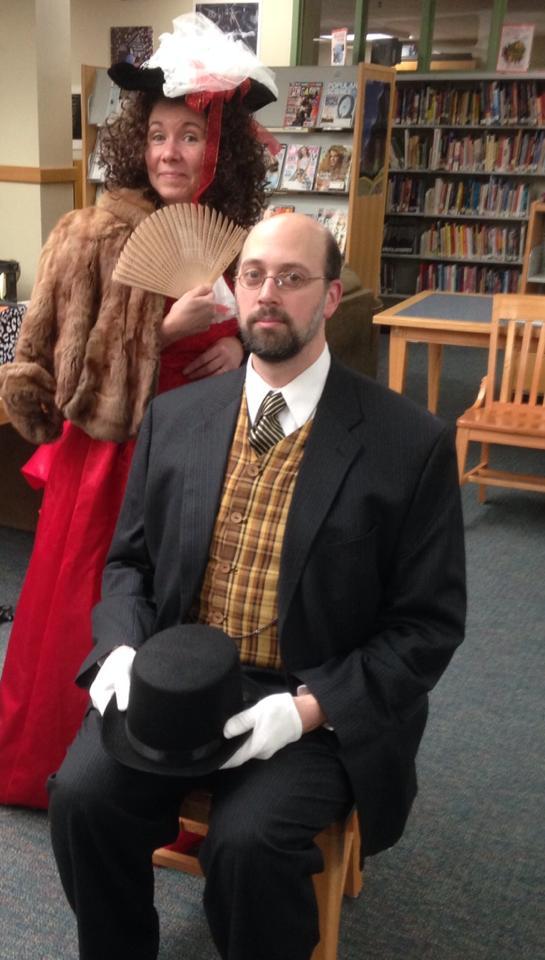
Lady London (left), a.k.a. librarian Tricia London, with an attending Lord.
A tall, uniformed butler at the entrance to the Avon (MA) Middle/High School Library, where I work, reads a calling card on a silver tray and announces in a booming voice: “Lady Yrvanie!” The lady in question curtsies and extends her gloved hand to Lady London (played by myself, left) and an attending Lord. Is this Downton AbbeyCon? No, it’s a library-based world history collaborative project that uses 19th-century artifacts to teach 20th-century investigative skills to freshmen. Ten years ago, I was clearing out family attics and found antique items including hoops, a corset, and bootjack. At the same time, my colleague, teacher Jay Donovan, was looking for a way to get students excited about history. I assembled my artifacts with my grandmother’s teacups and teapot, and a Victorian unit was born. This interdisciplinary project has become a school tradition that students remember long after graduation.Investigating Victorian artifacts
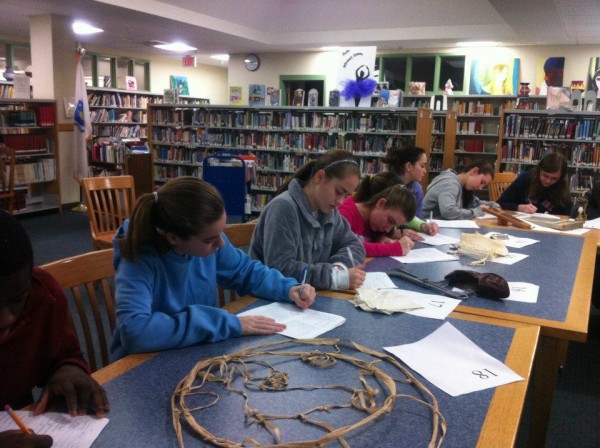
Students investigate artifacts including a hoop skirt, a washboard, and a bootjack.
The unit begins with a 20-piece artifact investigation. My original finds were augmented by an antique washboard, wringer, and sad irons purchased with an L.S.T.A. grant, along with a set of silver flatware donated by the superintendent of schools. Students examine the artifact and ask, “What is the artifact made from? What do you think it is used for, and is there a modern day equivalent?” Learning to ask good questions is such an important part of information literacy, and the critical thinking skills developed by students exploring these items help them to grow as observers and thinkers.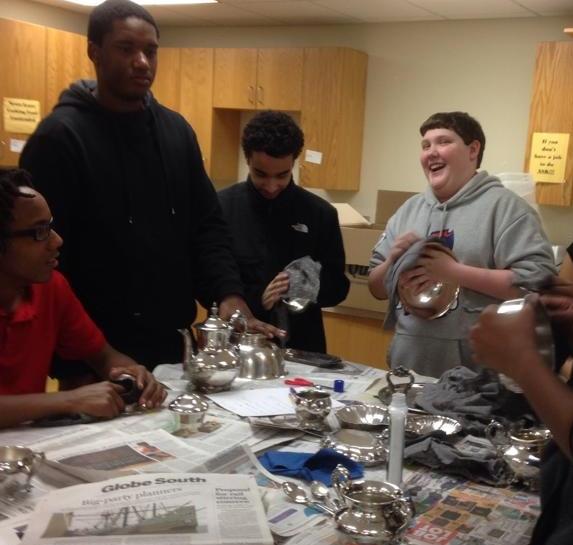
Polishing the silver.
Some artifacts stumped the investigators, like the pile of pages ripped from a Sears Catalog (toilet paper). Students discuss chamber pots and I show them pictures I took of a chamber pot belonging to Charles Dickens. Lady London even mentions “Southall's Sanitary Towels for Ladies” to the female students, making quite an impression. While the students role-play as Victorian servants, the era comes alive. They dust the library and wash and iron clothes using antiquated mangles and sad irons. They shine faculty members’ shoes. I model my Lady London character on the book You Wouldn’t Want to Be a Victorian Servant (Children's Pr., 2006) by Fiona MacDonald and also have them watch a few catchy Vile Victorian/Horrible History Youtube videos. Halfway through the unit, the servants morph into aristocracy. We discuss etiquette: Ladies are not to cross the ballroom without an escort, and they should never dance without gloves. Students practice stirring sugar cubes into their tea cups without clinking. They sew, waltz, and sing music of the era, and then send invitations to their families for a tea party, in painfully crafted cursive. The concluding tea party is open to the community and has been covered in the past by our local newspaper. Our library has bins of costumes, hats, ties, and gloves that students may borrow.Victorian journals
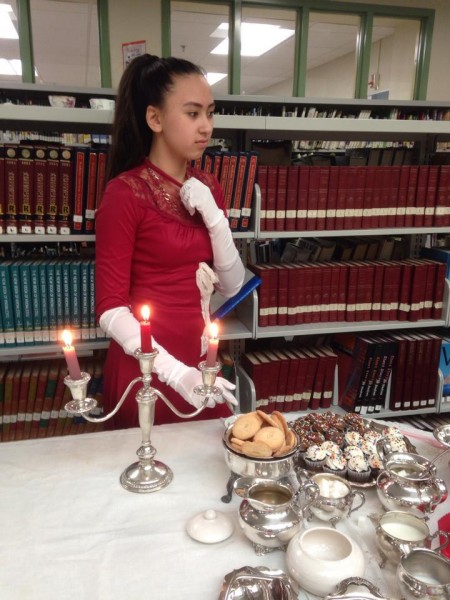
Lady Bang gets ready to help pour tea.
During the evenings, student servants write in their Victorian servant journal using Google Docs. They hone their research skills by making in-depth analyses of specific jobs using descriptions from Mrs. Beeton’s Book of Household Management, first published in 1861, and also refer to other primary sources and classroom experiences while writing their entries. When one student wrote, “It was cool getting the responsibility of going outside of the manor house on business.” Lady London politely typed “Was the temperature chilly on your errand, as this is what “cool” meant during our time period?” I used Bibliolabs Creator to curate a Biblioboard collection of primary sources. This tool allows one to put together books, images, videos and music found in the public domain into an attractive interface, worthy of Queen Victoria herself. I included Godey’s Lady's Book to let students research fashion of the day; the Beeton’s boot polish recipe is essential for all footmen. Students peruse the 1897 Sears Catalog to choose clothing (hats, gloves, corsets, boots, etc.)—and then calculate, by hand, of course, the percentage of their $97-a-year salary that would go towards their new garb. The project is truly interdisciplinary and includes poetry, singing, and dancing to “Let Me Call You Sweetheart." Scientific inquiry includes discussing why silver tarnishes and why tea curdles when students add lemon and milk. I also connect the time period to my own family. My great-grandmother was Victorian, my grandmother was of the flapper generation, and my mother was born a few days before the 1929 stock market crash. While students might not remember the exact dates of the Victorian era, they have a context to understand where it fits into world history. I also encourage them to explore their own family trees—which can open discussions about how libraries, both physical and electronic, are so vital to genealogy research.Cooking and critical thinking
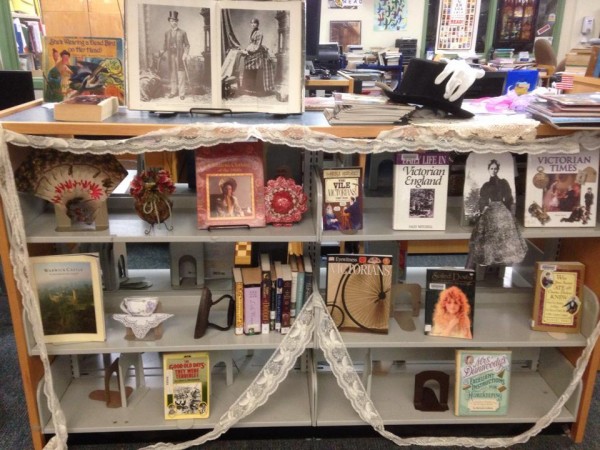
Primary and secondary sources that students refer to while writing in their Victorian journals.
While some activities always go smoothly, cooking usually isn’t one of them. Some recipes from the Biblioboard curated collection are unexpectedly challenging. Freshman Kristiana, who said her cookies came out like “little biscuits that exploded and were burned on the bottom,” pointed out that recipes weren’t “specific”—and she is correct! A gingersnap recipe from 1895 directs, “pour [in] just as little flour as will make it possible to roll out very thin and bake quickly.” Students are learning about more than just cookies. By parsing out unclear instructions and examining the available information sources, they can often glean the intended directions—boosting inferential and critical thinking skills. Kristiana also says this experience also gave her a new appreciation for “slice and bake.” All this effort is totally worth it for those “aha!” moments when a student gets excited about a discovery or a concept becomes clear to them. You can tell students that Victorian servants had a rough life—but when they become indignant when someone walks across their freshly scrubbed floor, they experience the frustration that servants undoubtedly did. Freshman Gabbie said that the project made her realize that there is “depth to history, instead of just taking notes….Plus, I also learned the right way to set a table!” Another student maintained that one of the few useful things he learned in high school was “how to sew on a button” during the Victorian unit. I like to think that he is a future novelist exploring the use of hyperbole. In addition to the large collection of secondary source materials I’ve amassed, I’ve also collected some tempting fiction of the era, in the hope it will entice even reluctant readers to pick up a book. Projects like this help students become more familiar with the library, the librarian, and the tools to unlock available knowledge, while also developing information literacy skills and a framework for research. One of my passions as a librarian is to instill a love of reading and to foster lifelong learners. For many students, I think the Victorian project does just that. Watch video: High Tea at the Avon Middle High School library (part 1) Watch video: High Tea at the Avon Middle High School library (part 2)More pictures on the library Facebook page.
 Tricia London has been the Avon (MA) Middle High School Librarian, serving students in grades 7–12, for the past 10 years. In her spare time, London enjoys choral singing and is a part- time reference and YA librarian at the Westwood (MA) Public Library. She enjoys tea.
Tricia London has been the Avon (MA) Middle High School Librarian, serving students in grades 7–12, for the past 10 years. In her spare time, London enjoys choral singing and is a part- time reference and YA librarian at the Westwood (MA) Public Library. She enjoys tea. RELATED
RECOMMENDED
CAREERS
The job outlook in 2030: Librarians will be in demand
CAREERS
The job outlook in 2030: Librarians will be in demand
ALREADY A SUBSCRIBER? LOG IN
We are currently offering this content for free. Sign up now to activate your personal profile, where you can save articles for future viewing






Add Comment :-
Comment Policy:
Comment should not be empty !!!
Laura Gardner
Thank you for sharing! Way to go, Tricia!Posted : Jul 06, 2015 09:49